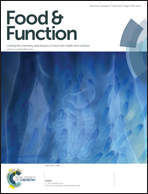Effects of Pu-erh tea aqueous extract (PTAE) on blood lipid metabolism enzymes
Abstract
Disorders of blood lipid metabolism are the primary risk factors for many diseases. Recently, the effect of Pu-erh tea on blood lipid metabolism has received increasing attention. However, the mechanism underlying its ability to regulate blood lipid metabolism is unclear. We set out to study this through assessing the effects of Pu-erh tea aqueous extract (PTAE) on the central enzymes of blood lipid metabolism, including lipoprotein-associated phospholipase A2 (Lp-PLA2), lecithin: cholesterol acyltransferase (LCAT), 3-hydroxy-3-methylglutaryl coenzyme A reductase (HMGR) and pancreatic lipase (PL). We find that the Lp-PLA2, HMRG and PL activities are inhibited by PTAE in a dose-dependent manner and that the LCAT activity tends to increase with increasing PTAE concentrations. Lineweaver–Burk plot analyses reveal that PTAE acts as a competitive inhibitor for HMGR and PL and as a noncompetitive inhibitor for Lp-PLA2. Moreover, we determine that its active ingredients include catechins, gallic acid, caffeine, free amino acids, and soluble sugar. However, the effect of each ingredient and whether any of them have synergistic effects are still unknown. The results suggest that Pu-erh tea has a potent ability to regulate blood lipid metabolism and knowledge of the mechanisms provides insights into its potential therapeutic application as an alternative hypolipidemic drug.


 Please wait while we load your content...
Please wait while we load your content...